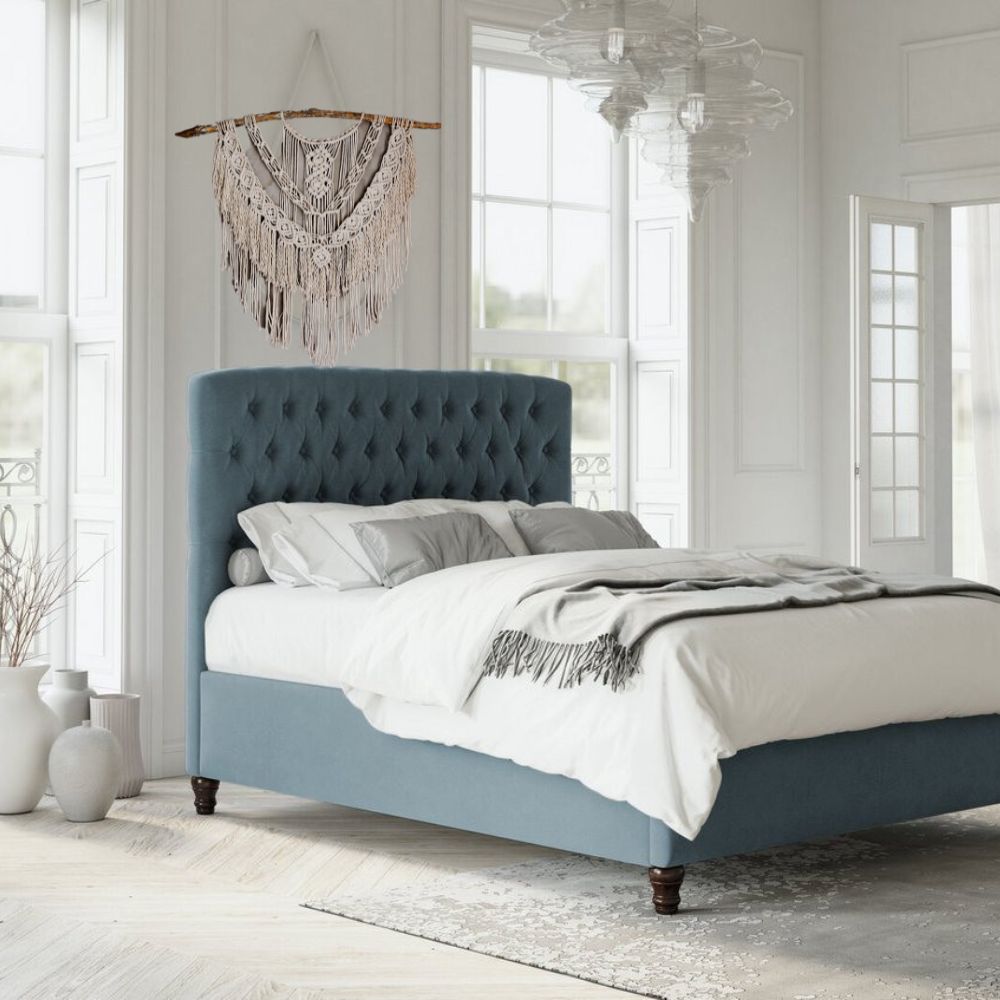How To Get The Best Sleep Using Feng Shui
31st Aug 2022Posted by Alice Ewens on 31st Aug 2022
Posted by Alice Ewens on 31st Aug 2022
Many of us are constantly trying to master how to get the best sleep. But we often overlook the space we're trying to fall asleep in. The Chinese philosophy of Feng Shui can help create a calming atmosphere and harness 'good energy' to help us drift off effortlessly. We take a look at the how and the why.
"Feng Shui" is a Chinese practice of arranging buildings or furniture to create harmony and balance with the natural world. It has its roots in ancient Taoism and the belief in 'chi', or the life force, that inhabits everything - including your furniture and the materials it's all made of - which have either yin or yang elements. Yin and yang are opposite but complementary forces. Feng Shui balances yin and yang energies plus the natural elements of air, water, fire, earth and metal to create harmony. Interiors experts today still use the principles to create room layouts.
Feng Shui can help us create the perfect calm, healing bedroom space right down to selecting the best materials to include and where to place them to harness that balanced chi. It can be hard to incorporate every single 'rule' for a Feng Shui bedroom. But, you can include a few elements to improve the energy flow and help you get a good night's sleep. Let's take a look at how.
One of the easiest ways to balance the chi in your bedroom is to design using pairs. Two or four pillows on the bed, two bedside tables, one on either side of the bed. Two lamps. Two chairs. A Feng Shui bedroom is perfectly balanced!
Feng Shui is a minimalist principle, so it's time for a clear-out. You want to be able to see as much of the floor as possible, to ground the energy of the room. This means strategic storage: bedside tables on legs, storage boxes, drawers, trunks etc. to keep things off the floor and out of sight. Try not to store anything under the bed bit if you must, keep it to soft fabric items, like bedding, pillows or soft clothes).



Mirrors are actually considered a bit of a no-go in a Feng Shui bedroom. This is because mirrors are said to add another uninvited person into your space or relationship! If you do need a mirror, consider placing it inside a wardrobe door or at least angled so you can see the door from your bed. Definitely avoid placing a mirror directly opposite or above a bed!
Too many plants in the bedroom can unbalance the earth and water elements in the room. Plants are heavy on the yang or expansive growth energy, which can disrupt sleep. If you're going to go for plants in the bedroom, go for two small matching small pot plants on either side of the bed.
Avoid placing anything heavy, such as artwork, mirrors or a bookshelf above the bed. You should also avoid having a heavy chandelier or pendant light directly above the bed. This is a heavy threatening energy, and imagining something falling on us in the night certainly makes us feel a bit uneasy. Instead, opt for a light, flowing tapestry if you want to hang anything over the bed.


Rounded edges soften the energy in the room, making it calmer. When a sharp edge points diagonally at the bed it's known as a 'poison arrow' in Feng Shui! You can soften by placing bedside tables either side of the bed (to make the bed space wider and deflect the pointy energy) or place a rug runner or bench at the foot of the bed (to absorb the energy). Fabrics and upholstered headboards can also help round off edges.
If you can, try to avoid wardrobes in your room (or go for a built-in or cupboard wardrobe that seamlessly blends into the wall). Tall furniture can bring oppressive yang energy into the room. If you need bookshelves to be placed above bed height, lay your books flat to add more gentle yin energy.

No desk, no TV or laptop. Try to avoid lots of electronics. Avoid work-out spaces or gym equipment, or sitting on the bed to work. If you do need these things in your bedroom, it's better Feng Shui to hide them behind a screen or curtain. A folding desk that can flatten against a wall or a slender wooden desk that you can slide a stool under would work.



Wood is a great material to incorporate into your bedroom as it's considered stable and safe. A bed with a wooden headboard is thought to provide a supported and protected sleep.
Greens and blues with neutral tones will tap into 'earth' yang energy to ground the room, creating a relaxing space. Don't go too bold or bright with your greens and blues, as this leans too far into yang socialising energy. Save those for your living spaces rather than sleep spaces.
A wooden bed frame upholstered in soft, light-coloured velvets will invite restful yin energy, and soften those harsh corners. Other furnishings and accessories in fluffy, soft fabrics will also work well. But remember not to go too overboard into 'cluttered' territory. Match cushions in pairs!
In Feng Shui, your bed should be the dominant thing in your room (if it struggles to stand out, a mirror opposite can actually help here! It's the one time a mirror can work to improve the chi of a room!). Opt for a wooden-framed bed with a headboard as this provides stable and safe energy. Place your bed with its headboard against a wall, not a window. Between windows is good, though. Avoid placing the headboard against a wall shared with a bathroom (which can bring in too much water energy). Your bed should be placed so you can see the door but not directly in front, to help you feel more secure in your space.

Taking everything we've discussed above, we've created a couple of example room layouts that work on Feng Shui principles. The first is an 'ideal' and the second is about offsetting some of the negative 'chi' flows that can pop up when needing a bedroom that needs to be more functional in a modern home.

1 - The bed is the dominant feature in the room, positioned with the headboard against a wall between two windows.
2 - Matching low-level bedside tables with lamps and 2 small pot plants.
3 - A chest of drawers or desk. It's wider than the bed, so the negative energy flow created by sharp corners and diagonal lines (4) is neutralised.
5 - The door can be seen from the bed but is not opposite the bed.
6 - A mirror can be hung here, as it has a neutral reflection of the window and the view can be seen from the bed.
7 - Nothing heavy hung over the bed, but a soft tapestry can add interest without bad Chi.

1 - Again, the bed is dominant in the room (if other objects seem to take more attention, hang a mirror opposite the bed).
2 - The door is still visible from the bed, but not directly opposite.
3 - Chests of drawers (avoid anything too tall if you can) offer storage space.
4 - The diagonal energy flow from the sharp corners is absorbed by rug runners (5) that extend out past the end of the bed.
6 - The desk is positioned so it doesn't overlap with the bed. Two small pot plants on either end of the desk help neutralise the sharp corners.
7 - The diagonal energy from the chest of drawers is neutralised by the pot plant on the desk.
8 - The diagonal energy from the desk toward the bed is neutralised by the rug runner (5).

Looking for small bedroom storage ideas? Look no further! We know it's easy when faced with a small bedroom to struggle with keeping your stuff neat, tidy and out of sight. When space is a premium, you want solutions that don't make the space feel more cramped![read more...]
Looking for ideas on how to get on that luxury kids and teens bedroom trend without breaking the bank? We got you. Listen up, school's *in* for summer.
[read more...]